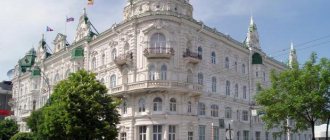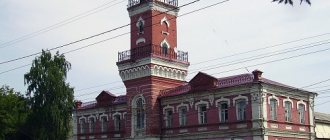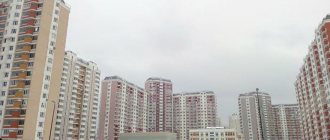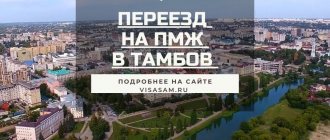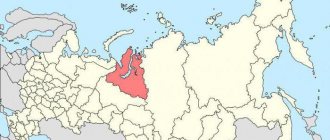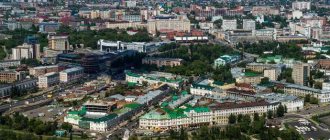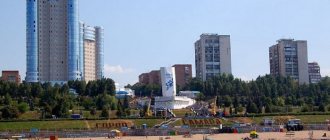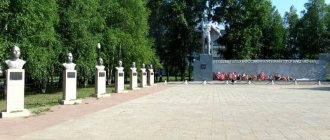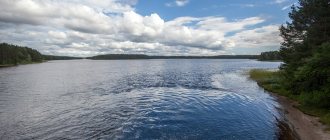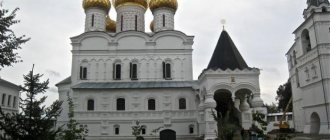There are many settlements in Russia with similar or identical names, most often these are small villages and hamlets. But there are also quite large administrative units with the same name, but different fates. For example, in our country there are two cities of Zheleznogorsk: one is located in the northwest near the city of Kursk, the other is in the northeast, 35 km from Krasnoyarsk.
History of Zheleznogorsk, Krasnoyarsk Territory
Until now, the city is an important strategic site and is considered a closed administrative unit. More than 50 years ago, disgraced scientists and engineers worked in these parts to create plutonium and other nuclear elements. Since 1985, a tunnel has been located here under 40 km of earth, where radioactive waste left over from uranium processing is stored. Although scientists claim low radiation contamination of the air in the region, isolated cases of harm to health occur from time to time.
The population of Zheleznogorsk still consists of scientists, workers, military personnel and their families. Entry into the city is carried out using special passes. Cars from other regions are allowed through only with special permission. The city exists thanks to Russia's largest chemical and mining plants, which serve the country's military and space sectors.
Routes on the map of Zheleznogorsk. Transport connection
Zheleznogorsk has developed transport links. A142 highway passes through the city , which connects the M2 and M3 . It is laid across flat terrain and is a regular two-lane road.
In the eastern part of the settlement there is a single-track non-electrified railway line Orel-Lgov , on which the nearest station is Mikhailovsky Rudnik. It is the terminus for commuter trains coming from Orel. Transit passenger trains going to Lgov also pass through it.
Attractions
Despite the rather small population of Zheleznogorsk, less than 85 thousand people, the city has a widely developed cultural infrastructure. Thus, unique museums are opened here, where exhibits related to the mining and chemical industry are exhibited, as well as exhibitions that tell the story of the first workers, forced prisoners of the Gulag. Along with the mining museum, there is also an archaeological center where miners' finds are exhibited.
In addition to the Central City Library, small centers for reading enthusiasts are open in all districts. In 2010, Zheleznogorsk was even named the cultural capital of the Krasnoyarsk Territory.
Surprisingly, for 85 thousand people there are 4 theaters and 2 theater studios: the Operetta Theater, the Children's Puppet Theater, the Sovremennik Youth Theater and the People's Drama Theater named after. Ostrovsky.
Number, national composition
The population of Zheleznogorsk, Krasnoyarsk Territory, has changed little over the past 50 years. According to the 1979 census, 87 thousand people lived in the city. A small surge was observed in the mid-90s, when this figure reached 95-97 thousand people. But now, according to 2021 data, 84 thousand people live in Zheleznogorsk.
This consistency is due to the specifics of this area. This is not just a settlement, but a strategic zone with important objects of national importance. Enterprises require a certain number of workers, so there was no sharp decline in difficult years for the country. The population of Zheleznogorsk did not leave en masse for large centers, because there was stable work here too.
Climatic and environmental conditions
Zheleznogorsk is located in a zone of sharply continental climate. Due to the low humidity, winter frosts and summer heat are easily tolerated here. After the commissioning of the Krasnoyarsk hydroelectric power station and the appearance of the reservoir, winters became milder. Probably many people think that in such cities of nuclear scientists there is an increased background radiation. Winds blowing from Krasnoyarsk bring more harmful substances to Zheleznogorsk. They carry emissions from industrial enterprises.
Zheleznogorsk is surrounded by a forest belt that purifies the air. There are several boards installed on the buildings that show background radiation. Usually it is 4 times less than acceptable. The content of radionuclides in food does not differ from the national average.
The modern problem of employment
Today, the problem of finding a job even in such a seemingly prosperous city exists. The problem is the specific jobs that the city can provide, as well as the automation or even closure of some important infrastructure.
The Employment Center of Zheleznogorsk, Krasnoyarsk Region, like all similar institutions, is a state structure. It provides city residents with assistance in finding work, retraining opportunities and other services of a similar nature. Citizens can receive help completely free of charge.
The employment center of Zheleznogorsk, Krasnoyarsk Territory is located at 662971, Zheleznogorsk, Pionersky proezd, 6, post office box 32. Detailed information about existing vacancies can be found on the official website of the center. The list of jobs includes many offers for engineers in various fields, and salaries are higher than the national average. There is also a great demand for drivers, construction workers, finishers, support workers and doctors.
main feature
When designing the city, engineers tried to preserve the natural beauty of the taiga as much as possible. Therefore, the old and new quarters of Zheleznogorsk are designed in such a way that there is greenery everywhere. There are no frequent buildings here, as in other cities; if you look at the streets from the neighboring island, it seems that the houses are adjacent to the taiga.
In addition, next to residential areas on a hill there are ski slopes of different heights and distances. The city was designed by Leningrad engineers, and the park was originally planned without a lake. But local residents, on their own initiative, cleared the floodplain under the reservoir and built dams. Now there is a park with ancient trees and the pearl of Zheleznogorsk - a beautiful and clean pond.
History of Zheleznogorsk, Kursk region
Another city of the same name is located in the opposite part of Russia near Kursk. It is a populated area of regional significance. Like the previous city in the Krasnoyarsk Territory, Zheleznogorsk in the Kursk Region was founded in the 50s of the 20th century. The reason was the discovery of the Kursk magnetic anomaly, one of the largest and most powerful iron ore basins in the world. In 1962 it received its present name. Previously, the village was called Oktyabrsky.
Already in 1962, the population of Zheleznogorsk, Kursk region, amounted to more than 16 thousand people, and the village received the status of a city. It seems to be divided into two parts, in the western part there are mainly residential buildings and other urban infrastructure, and in the eastern part there are industrial facilities, railway tracks and other industrial zones. Neighboring small settlements have been included in the city district for several years now, and since 2010 they have been recognized as microdistricts of the regional center.
Zheleznogorsk
(Kursk region)
OKATO code:
38405
Founded:
1957
Urban settlement since:
1958
City since:
1962 City of regional subordination
Center:
Zheleznogorsk district
Telephone code (reference phone)
| 47148***** | 91-2-09 |
Deviation from Moscow time, hours:
0
Geographic latitude:
52°20′
Geographic longitude:
35°22′
Altitude above sea level, meters:
220 Sunrise and sunset times of the Sun and Moon in the city of Zheleznogorsk
Attractions
The entire life of the population of Zheleznogorsk is connected with the extraction of iron ore raw materials. Mikhailovsky GOK is the largest enterprise not only in the region, but throughout Russia. More than 30% of the residents work here, and the entire budget is formed precisely at the expense of the industrial giant.
The city is small in size, but there are 8 schools and several gymnasiums, a central city library and smaller institutions of this kind are open. In addition, there are several dozen different clubs for the development of children, including the Young Naturalists Club, cultural clubs and Alice.
Zheleznogorsk is famous for its local history museum, as well as exhibitions related to the history of the development of the region. The city has several sports complexes, swimming pools, and military-patriotic clubs.
Architecture and housing stock of Zheleznogorsk
On the map of Zheleznogorsk with houses you can find a wide variety of housing stock. In total, there are about 500 houses of different years of construction in the city. Most of them (32%) are houses that appeared in the 70s of the last century. The earliest buildings were erected in the 50s.
In the second decade of the 21st century, several dozen modern houses with comfortable apartments were built in the city. These include panel and prefabricated frame multi-apartment residential buildings,
Number, national composition
Since 1959, there has been a constant increase in the city's population. For more than 50 years, virtually no demographic declines have been recorded. Today, together with the towns and villages included in the urban district, the population of Zheleznogorsk is slightly more than 100 thousand people.
This stable density is explained by the success of the city-forming enterprise. Local quarries still generate multimillion-dollar revenues. So residents do not need to leave in search of work in other regions.
Mostly Russians live in the city - more than 98%. In a smaller proportion here are Ukrainians, Jews, Armenians and Belarusians. Only Orthodox churches and temples are functioning.
Job search problem
The employment center of Zheleznogorsk is located at the address: Kursk region, Zheleznogorsk, Gagarina street, 10a. The government agency provides citizens with a job search service. In case of insufficient qualifications, a person has the right to undergo free retraining or advanced training courses.
Today, the employment center of Zheleznogorsk, Kursk region, offers vacancies in technological professions - engineer, mechanic, electrician; in addition, managers of various levels are required - from administrators to directors.
Zheleznogorsk is an inexpensive and promising city in terms of accommodation. There are 20 industrial enterprises there, and specialists such as engineers, economists or geologists are always welcome here.
Today Zheleznogorsk is a young and beautiful city with developed infrastructure. The population today is about 100 thousand people.
Despite its youth, Zheleznogorsk has repeatedly won competitions among small towns in Russia and the Kursk region on the improvement and level of development of education, culture and sports.
Zheleznogorsk has changed noticeably in recent years. In a sense, he is experiencing his rebirth. Old buildings are being updated and restored, new industrial and residential facilities are being put into operation.
The city has been exploring and working on different options for solving the housing problem for a long time: preferential loans for housing construction, reconstruction of former dormitories. Some large enterprises offer their workers good opportunities to improve living conditions: JSC Mikhailovsky GOK, JSC ZhBI-3, JSC GOTEK, JSC Matis. At the city level, a municipal mortgage lending program has been adopted.
The stability of the work of municipal housing and communal services enterprises makes it possible for city residents, despite the general energy crisis in the country, to be fully provided with heat, gas, and electrical energy. And the municipal unitary enterprise "Gorvodokanal" has been repeatedly recognized as the best among related enterprises in Russia, in the category of settlements with 100 thousand people. It is noteworthy that Zheleznogorsk has completely abandoned the use of chlorine in the purification of drinking water and wastewater. Now disinfection is carried out using ultraviolet light.
About 700 commercial and trade enterprises have been created in the city. Small businesses continue to constantly evolve. There are 2 large markets in the city, as well as a network of mini-markets in neighborhoods.
In Zheleznogorsk, much attention is paid to veterans, lonely and elderly people. We have one of the best boarding houses for war and labor veterans in the region, and a comprehensive center for social services for the population. The city council of war and labor veterans in each microdistrict has its own asset. And what kind. Thanks to him, enormous work is being done in lyceums, schools and kindergartens on the patriotic education of youth.
Medical services are provided by 2 hospitals, a maternity hospital, a drug treatment clinic, 2 general clinics, and an ambulance station. The technique of implantology and metal-ceramics was practically put into production in the dental clinic and this institution received the status of “innovative Zoryushka”; in 2005, a children’s clinic was put into operation. The city's medicine is represented by more than 400 doctors.
There are 21 kindergartens in Zheleznogorsk; 13 secondary schools, including lyceums and gymnasiums; 1 primary school, 1 evening school, interschool training center, 6 institutions of additional education, 1 vocational lyceum, polytechnic college and one school, Mikhailovsky Mining and Processing College, art school, Druzhba choir school, art school, school of folk crafts "Artel". Higher educational institutions are represented by 8 branches and representative offices of various universities in the country. Sports Zheleznogorsk has 5 swimming pools, a stadium, and 11 sports facilities.
Young Zheleznogorsk residents are not only patriots of their city and Russia, they are hardworking, smart, athletic and culturally educated. It is an undeniable fact that Zheleznogorsk athletes successfully and efficiently took part in zonal competitions, championships and championships of Russia, Europe and the World. Here are some of them: Ekaterina Volkova, Olesya Chumakova, Denis Zhalybin, Armen Martirosyan, Elena Tarasenko. Zheleznogorsk athletes also took part in the 2004 Olympics in Athens - Alexander Pogorelov and Pavel Potapovich. Zheleznogorsk residents also entered the Russian national team for the Beijing Olympics, which took place in 2008 - Alexander Pogorelov in the decathlon, Pavel Potapovich in the 3000 m steeplechase, Ekaterina Volkova in the 3000 m steeplechase. As a result, Ekaterina Volkova became a bronze medalist at the Beijing Olympics.
The culture of Zheleznogorsk is represented by a network of libraries, cultural centers, and museums. Since 1997, the exhibition hall of the local history museum has been operating in the city, since 1977. Museum "Partisan Glory" at the Big Oak memorial.
The city also has its own very young arboretum. Trees and shrubs of more than 350 species, brought from different parts of the country, have found their second home here.
Zheleznogorsk media are represented by 4 newspapers: “Zheleznogorsk News”, “Echo of the Week”, “Kursk Ore” and “Zhizn Raion”. City television, Signal TV, operates and continues to improve. There are also a number of corporate media outlets. The radio broadcast is represented by two radios and the terrestrial radio “Maximum” of STV Media LLC.
In accordance with the Charter of the municipal municipality "city of Zheleznogorsk" of the Kursk region, City Day is celebrated on the last weekend of September.
